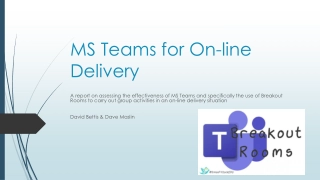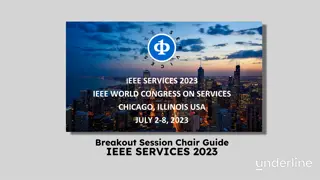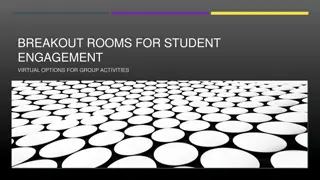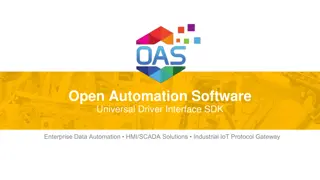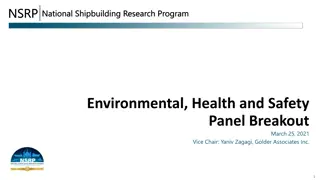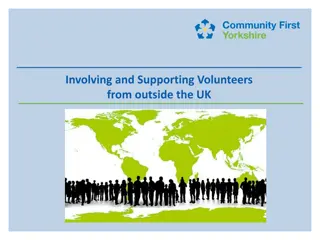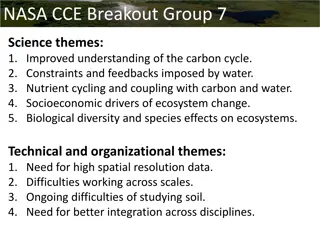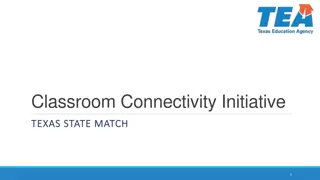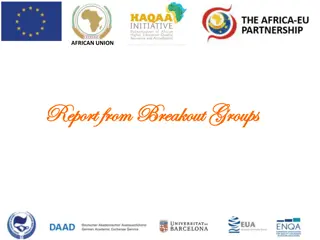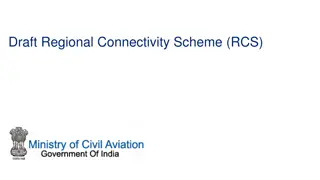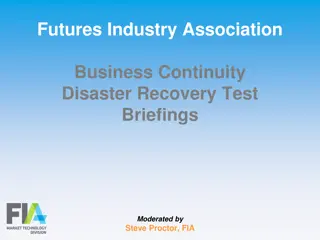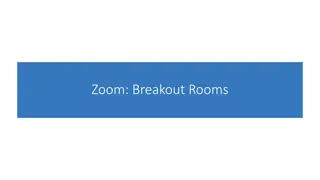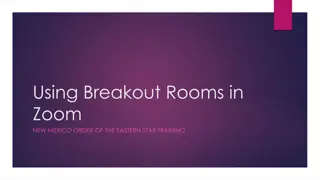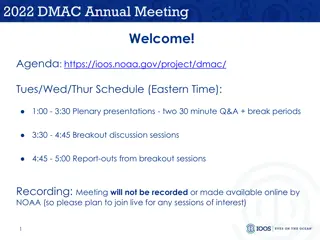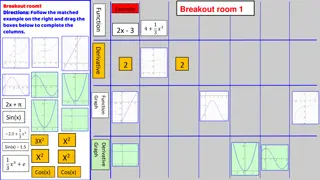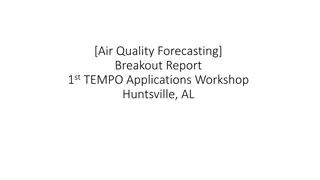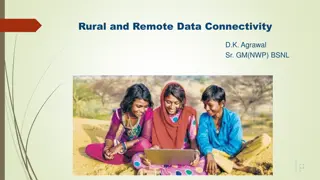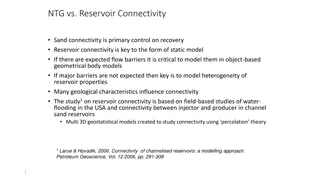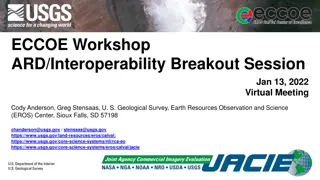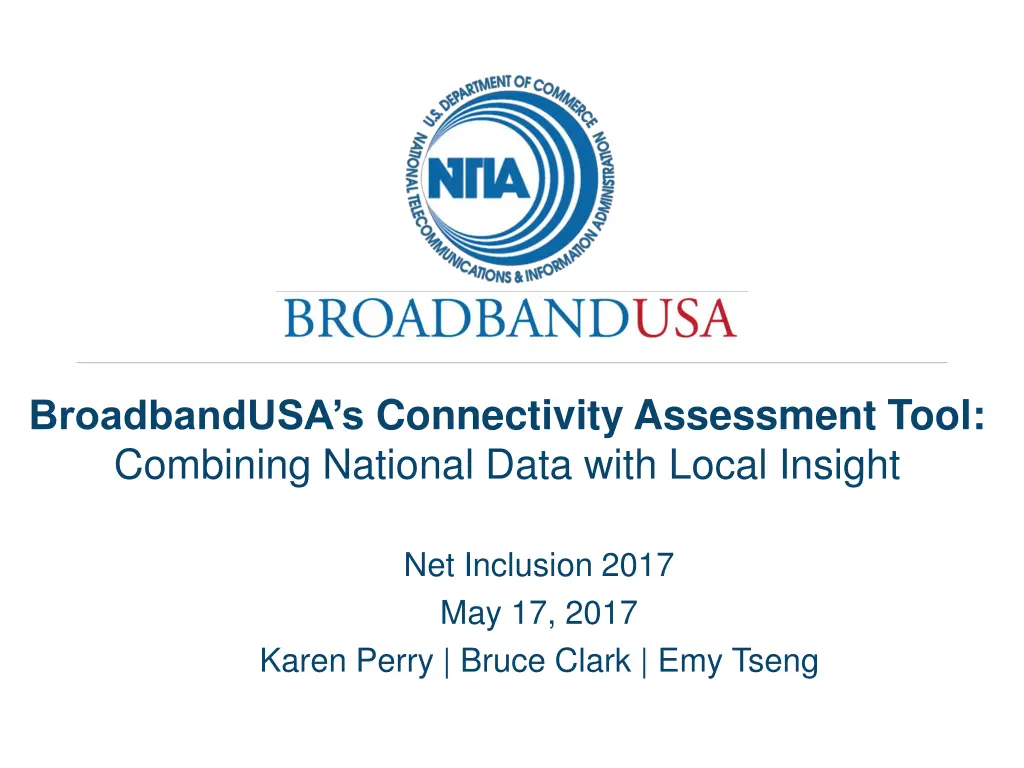
Connectivity Assessment Tool Overview
Explore the BroadbandUSA Connectivity Assessment Tool designed to accelerate community broadband planning and progress by combining national data with local insight. This tool aims to enhance resource relevance, engage more communities, and facilitate a holistic planning approach for advancing broadband access and adoption. Learn about the framework, vision, update results, and upcoming beta test objectives and scope.
Download Presentation

Please find below an Image/Link to download the presentation.
The content on the website is provided AS IS for your information and personal use only. It may not be sold, licensed, or shared on other websites without obtaining consent from the author. If you encounter any issues during the download, it is possible that the publisher has removed the file from their server.
You are allowed to download the files provided on this website for personal or commercial use, subject to the condition that they are used lawfully. All files are the property of their respective owners.
The content on the website is provided AS IS for your information and personal use only. It may not be sold, licensed, or shared on other websites without obtaining consent from the author.
E N D
Presentation Transcript
BroadbandUSAs Connectivity Assessment Tool: Combining National Data with Local Insight Net Inclusion 2017 May 17, 2017 Karen Perry | Bruce Clark | Emy Tseng
Agenda Values Project update Framework Break outs Wrap up Leverage Learn Deliver Progress
BroadbandUSA Connectivity Assessment Tool Vision Accelerate community broadband planning, action, and progress. Better outcomes in less time Increase resource relevance & usability Facilitate holist planning approach Engage more communities Advance broadband access, improve adoption, strengthen policies Quick Start Framework Assessment Local Report Resources
BroadbandUSA Connectivity Assessment Tool Update Result Value Process 800+ stakeholders consulted 12 measurement programs incorporated 8 systems change models reviewed Community Connectivity Framework Online assessment tool Deep partnerships with field Structured Planning National data Collaboration tool Flexible path Support for action
BroadbandUSA Connectivity Assessment Framework Three sectors 12 modules ~160 questions Localized data from U.S Census, NTIA Digital Nation, FCC 477 Action reports Recommended resources
Beta Test of Online Tool Starts This Week! 15 communities; 12 users per community; 3 month beta period AL WA ME NCC / NDIA Alexander City Selma Stevens County Lincoln County White Center Piscataquis County Franklin County Lincoln County Long Island Vinalhaven Charlotte NC San Antonio TX Louisville KY Kansas City MO Additional collaborators: NLC, NACO, ICMA, ALA
Beta Test Objectives and Scope Evaluation Scope User flow and process Assessment questions and responses Ease of use Administrative functions incl. user roles Training and support needs Recommended resources Reports and downloads Framework language and structure Benefit and burden hours Areas for improvement Additional planning support; what other tools can BBUSA create to reduce planning cost Objectives Deliver online planning tool Provide localized views of national data Test assumptions and improve Capture feedback to inform future work Identify additional opportunities to support local leaders Provide wrap-around services
Adoption Digital Inclusion and Workforce Skills Adoption and Use:Who is using the Internet? Are there digital divides? Digital Inclusion:What proactive measures are you taking to ensure digital equity? Digital Skills:Do programs provide a ladder for residents to gain digital proficiencies - from basics to coding? Devices:Do people have access to the devices they need to learn, create and participate?
Whats in a Module? Outreach to vulnerable populations Digital literacy training and support Broadband discount and subsidy programs Device discount, loan or checkout programs Accessible design Sustainable funding to promote digital equity Digital inclusion self-assessment Digital inclusion narrative Digital inclusion links and resources Digital Inclusion What proactive measures are you taking to ensure digital equity?
Wake County Residential Providers (477) Wake County Residential Service Providers Provider Technology Blocks served AT&T Inc. aDSL 8390 AT&T Inc. Fiber 824 CenturyLink, Inc. aDSL 1610 CenturyLink, Inc. Fiber 154 Charter Communications Cable 14130 dishNET Holding, L.L.C. Satellite 160 Frontier Communications Corporation aDSL 323 Hotwire Communications, Ltd. Fiber 1 Hughes Network Systems Satellite 14108 Pivotal Global Capacity, LLC aDSL 100 ViaSat, Inc. Satellite 14108 VSAT Systems, LLC Satellite 14108 Windstream Holdings, Inc. aDSL 23 Windstream Holdings, Inc. Fiber 4
Digital Divides in North Carolina Digital Divides in North Caroline and the Country NC US 23.70% Percent of adults not using the Internet somewhere 28.40% Percent of adults not using the Internet at home 35.00% 29.60% People 15 or over with HS degree or less who do not use the Internet 45.50% 38.50% People 15 or over with a disability who do not use the Internet 18.60% 35.20% People 65 or older who do not use the Internet 47.60% 43.80%
Digital literacy training and support Is digital literacy training and support available to residents either as a stand-alone service or as part of other programs, such as those for education, housing, justice, or workforce development? Not at all ...To a large extent
Digital literacy training and support Stakeholders, such as libraries or other institutions, offer one-on-one technical support. Stakeholders, such as libraries or other institutions, offer free or affordable instructor-led digital skills classes. Stakeholders, such as libraries or other institutions, offer online classes in digital basics. Digital literacy training is integrated into government services that require digital competencies such as work force development, educational support, health services, and justice. Digital literacy classes are conducted in the language of the target audience(s). Digital literacy classes are accessible to people with disabilities. Program participants contribute to the program design. Staff are provided opportunities to continually enhance and upgrade their own digital literacy skills. Other (please specify)
Access Broadband Infrastructure and Availability Broadband Access:What wireline and fixed wireless broadband services are available in your area? Mobile Access:What cellular coverage and technology is available in your area? Provider Engagement:Are there opportunities to further strengthen partnerships with existing and new service providers? Public Assets:How do local policies support the use of public assets, enhance advanced telecommunications, and serve the public good?
Community Leadership and Context Leadership:Who are the broadband champions in your locality? Community Priorities:What issues draw us to take action to improve broadband? Stakeholder Engagement:How are you engaging stakeholders that can bring interest, influence, or support to local broadband initiatives? Policy Environment:Are there regional or state resources or regulations that impact local planning and investment?
Break-out: Identify new leverage to accelerate equity Break into three discussion groups: Digital Inclusion and Skills Emy Tseng Leadership and Community Context Bruce Clark Broadband Availability and Infrastructure Karen Perry Select one module that could more strongly impact Net Inclusion Discuss: How this could be a change lever to impact inclusion? What break-through actions we could take to accelerate inclusion? 1. 2. 3.
Read Out Module selected/ focus area Why we think this is a change lever? How we could drive break-through actions to accelerate inclusion?
For More Information Consult the BroadbandUSA website for more information and updates: http://www2.ntia.doc.gov/BCAT Email BroadbandUSA@ntia.doc.gov or call or write: Laura Spining LSpining@ntia.doc.gov (202) 482-5637 Karen Perry KPerry@ntia.doc.gov (206) 861-6043

